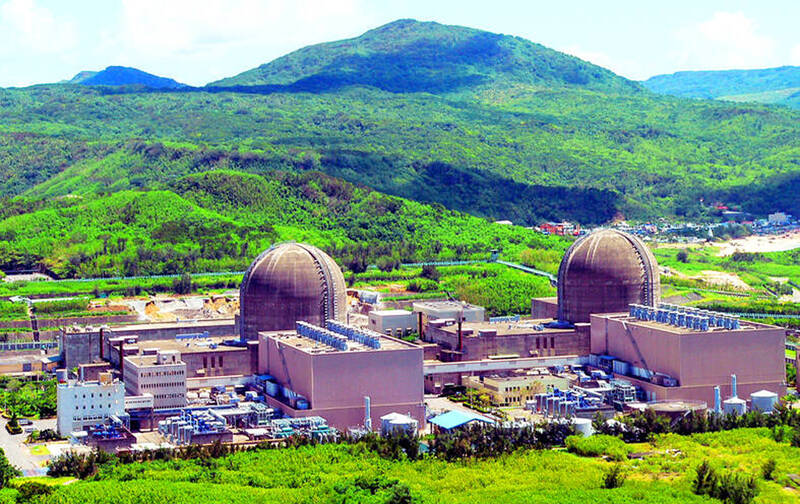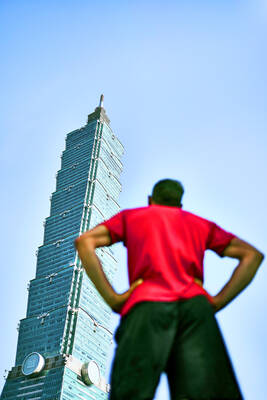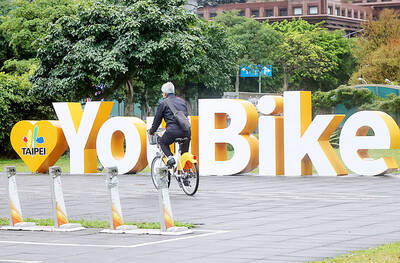Taiwan is turning off its last nuclear reactor today, fueling concerns over the nation’s reliance on imported energy and vulnerability to a Chinese blockade.
Taiwan, which targets net zero emissions by 2050, depends almost entirely on imported fossil fuel to power its homes, factories and critical semiconductor industry.
President William Lai’s (賴清德) Democratic Progressive Party has long vowed to phase out nuclear power, while the Chinese Nationalist Party (KMT) says continued supply from the technology is needed for energy security.

Photo courtesy of Taiwan Power Co
The Ma-anshan Nuclear Power Plant in Pingtung County is being closed as China intensifies military activity around Taiwan.
During large-scale military drills around Taiwan last month, China simulated strikes on key ports and energy sites, as well as blockading the nation.
Ma-anshan has operated for 40 years in a region popular with tourists, and which is now dotted with wind turbines and solar panels.
More renewable energy infrastructure is planned at the site, where state-owned Taiwan Power Co plans to build a solar power station capable of supplying an estimated 15,000 households annually.
However, while nuclear power only accounted for 4.2 percent of Taiwan’s supply last year, some fear that Ma-anshan’s closure risks an energy crunch.
“Taiwan is such a small place and currently there’s no other better and more efficient natural energy source that can replace nuclear power,” said Ricky Hsiao, 41, who runs a nearby guesthouse.
“The reality is that TSMC and other big companies need a lot of electricity. They would leave Taiwan if it’s not stable,” he said, referring to chipmaking giant Taiwan Semiconductor Manufacturing Co.
However, mother-of-two Carey Chen fears an accident like the 2011 Fukushima Dai-ichi nuclear power plant meltdown in Japan, which, like Taiwan, is prone to earthquakes.
“If we can find other stable power sources, I support a nuclear-free homeland for everyone’s safety,” said Chen, 40.
At its peak in the 1980s, nuclear power made up more than 50 percent of Taiwan’s energy generation, with three plants operating six reactors across the nation.
Concerns after the Fukushima disaster saw a new plant mothballed in 2014 before it was even finished. Two other plants stopped operating between 2018 and 2023 after their operating permits expired.
Most of Taiwan’s power is fossil fuel-based, with liquefied natural gas (LNG) accounting for 42.4 percent and coal 39.3 percent last year.
Renewable energy made up 11.6 percent, well short of the government’s target for this year of 20 percent.
Solar has faced opposition from communities worried about panels occupying valuable land, while rules requiring locally made parts in wind turbines have slowed their deployment.
Lai insists that Taiwan’s energy supply would be stable even as artificial intelligence technology boosts demand, with new units in existing LNG and coal-fired plants replacing Ma-anshan’s output.
The KMT and the Taiwan People’s Party, which together hold a majority in the Legislative Yuan, on Tuesday amended a law enabling nuclear plants to extend their operating life by up to 20 years.
“Nuclear power is not the most perfect way to generate electricity, but it is an option that should not be eliminated when we are developing technology, defense and strengthening national security,” KMT Legislator Ko Ju-chun (葛如鈞) said.
Taiwan’s reliance on imported fossil fuels is of particular concern given the risk of a Chinese blockade.
The nation has enough LNG and coal reserves to last just 11 and 30 days respectively, government data showed.
Taiwan’s centralized electricity grid also leaves swaths of the nation at risk of major power outages in case of a single fault.
Without nuclear power, “our energy security cannot be guaranteed and national security will be affected,” said Yeh Tsung-kuang (葉宗洸), an energy expert at National Tsing Hua University.
Environmentalists argue that renewables are the best way to bolster Taiwan’s energy resilience.
“If every community has solar panels on its roofs, the community can be [more] self-sufficient,” said Tsui Shu-hsin (崔愫欣), secretary-general of Green Citizens’ Action Alliance.
However, others say that Taiwan’s break-up with nuclear power generation is at odds with global and regional trends.
Even Japan aims for nuclear to account for 20 to 22 percent of its electricity generation by 2030, up from well under 10 percent now.
And nuclear power became South Korea’s largest source of electricity last year, accounting for 31.7 percent of its total power generation and reaching its highest level in 18 years, South Korean government data showed.
Hengchun Township (恆春) Mayor Yu Shih-ching (尤史經), who is head of the region where the Ma-anshan plant is, said that the facility had brought jobs and boosted the local economy.
“Our view is that nuclear power is necessary,” Yu said, calling it “an important driving force for the national economy” and a “great help to local areas.”
Lai said that he would not rule out a return to nuclear power one day.
“Whether or not we will use nuclear power in the future depends on three foundations: nuclear safety, a solution to nuclear waste and successful social dialogue,” he said.

US climber Alex Honnold is to attempt to scale Taipei 101 without a rope and harness in a live Netflix special on Jan. 24, the streaming platform announced on Wednesday. Accounting for the time difference, the two-hour broadcast of Honnold’s climb, called Skyscraper Live, is to air on Jan. 23 in the US, Netflix said in a statement. Honnold, 40, was the first person ever to free solo climb the 900m El Capitan rock formation in Yosemite National Park — a feat that was recorded and later made into the 2018 documentary film Free Solo. Netflix previewed Skyscraper Live in October, after videos

Starting on Jan. 1, YouBike riders must have insurance to use the service, and a six-month trial of NT$5 coupons under certain conditions would be implemented to balance bike shortages, a joint statement from transportation departments across Taipei, New Taipei City and Taoyuan announced yesterday. The rental bike system operator said that coupons would be offered to riders to rent bikes from full stations, for riders who take out an electric-assisted bike from a full station, and for riders who return a bike to an empty station. All riders with YouBike accounts are automatically eligible for the program, and each membership account

A classified Pentagon-produced, multiyear assessment — the Overmatch brief — highlighted unreported Chinese capabilities to destroy US military assets and identified US supply chain choke points, painting a disturbing picture of waning US military might, a New York Times editorial published on Monday said. US Secretary of Defense Pete Hegseth’s comments in November last year that “we lose every time” in Pentagon-conducted war games pitting the US against China further highlighted the uncertainty about the US’ capability to intervene in the event of a Chinese invasion of Taiwan. “It shows the Pentagon’s overreliance on expensive, vulnerable weapons as adversaries field cheap, technologically

NUMBERs IMBALANCE: More than 4 million Taiwanese have visited China this year, while only about half a million Chinese have visited here Beijing has yet to respond to Taiwan’s requests for negotiation over matters related to the recovery of cross-strait tourism, the Tourism Administration said yesterday. Taiwan’s tourism authority issued the statement after Chinese-language daily the China Times reported yesterday that the government’s policy of banning group tours to China does not stop Taiwanese from visiting the country. As of October, more than 4.2 million had traveled to China this year, exceeding last year. Beijing estimated the number of Taiwanese tourists in China could reach 4.5 million this year. By contrast, only 500,000 Chinese tourists are expected in Taiwan, the report said. The report